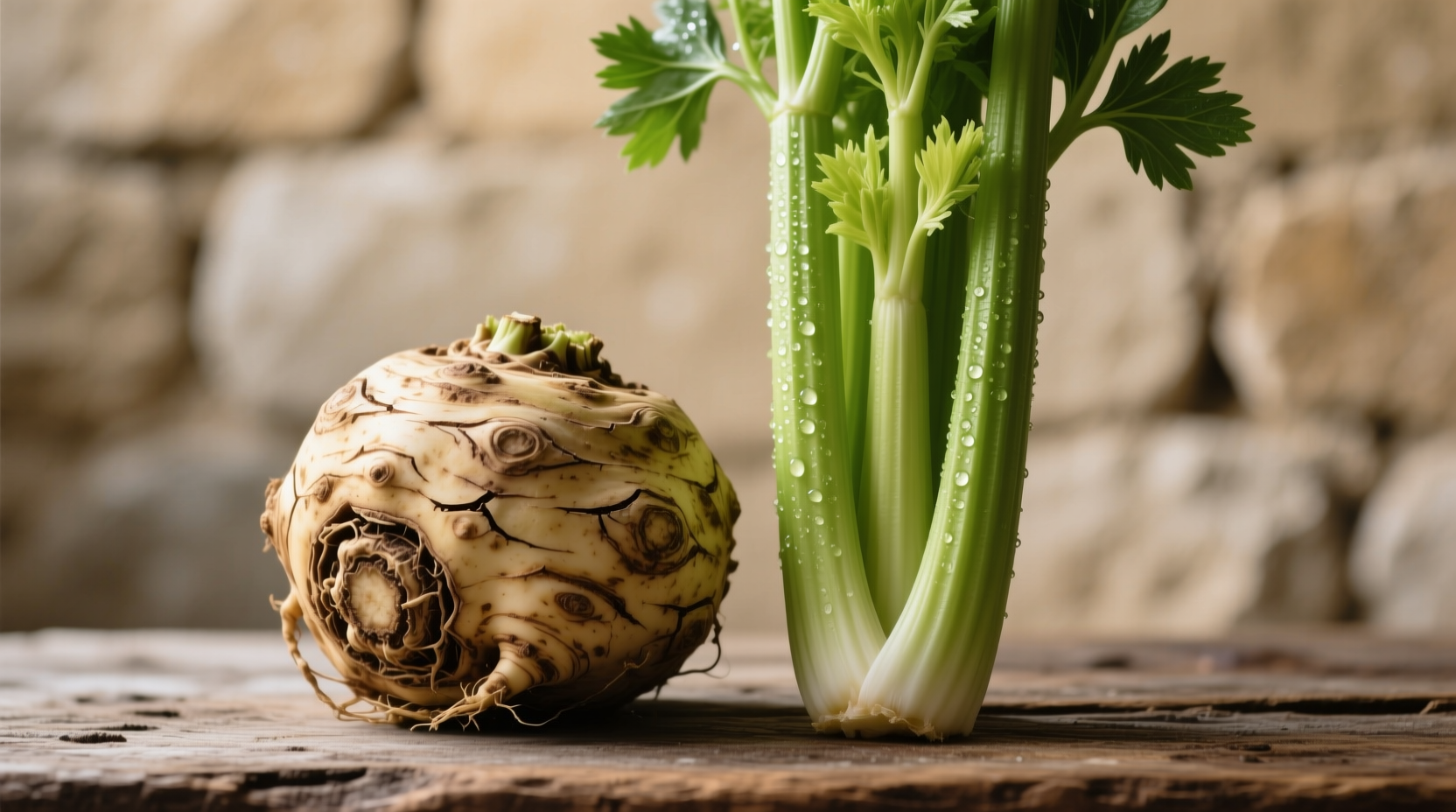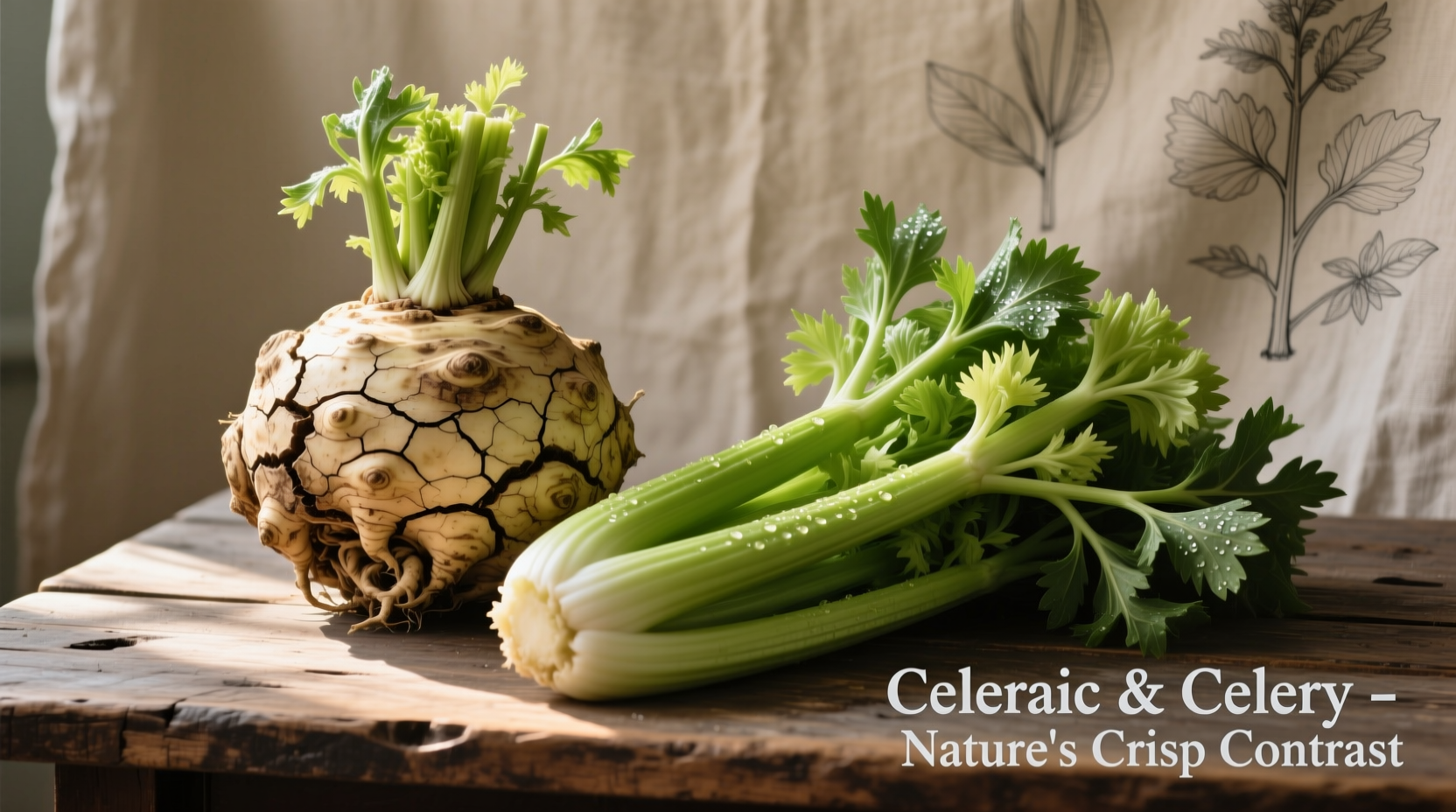Celeriac and celery are distinct varieties of the same plant species (Apium graveolens), selectively bred for different edible parts. Celery is cultivated for its crisp, fibrous stalks, while celeriac—also known as celery root—is grown specifically for its large, knobby root bulb. Despite their botanical relationship, they differ significantly in flavor profile, culinary applications, and nutritional composition.
Clearing Up the Confusion: What Sets Celeriac and Celery Apart
Many home cooks mistakenly believe celeriac is simply another name for celery or a specific celery variety. This confusion leads to recipe failures and shopping frustrations. Understanding the fundamental differences between these two vegetables prevents culinary mishaps and expands your cooking repertoire.
| Characteristic | Celeriac (Celery Root) | Celery |
|---|---|---|
| Botanical Name | Apium graveolens var. rapaceum | Apium graveolens var. dulce |
| Primary Edible Part | Swollen root bulb | Leafy stalks (petioles) |
| Flavor Profile | Earthy, nutty, subtle celery-parsley blend | Pronounced celery flavor, crisp and watery |
| Texture (Raw) | Firm, dense, similar to potato | Crisp, fibrous, high water content |
| Texture (Cooked) | Creamy, smooth when pureed | Softens but retains some structure |
| Seasonality | Fall through early spring | Available year-round |
| Storage Life | 3-4 weeks refrigerated | 1-2 weeks refrigerated |
From Ancient Herb to Modern Staple: A Botanical Timeline
Understanding the historical divergence of these plants explains their current forms. Both originated from wild celery (Apium graveolens), native to Mediterranean wetlands and used medicinally since ancient times.
- 16th century: European gardeners began cultivating celery primarily for medicinal purposes, valuing its diuretic properties documented in early herbals like John Gerard's Herball (1597)
- Late 17th century: Selective breeding in France and Italy produced the first recognizable celery stalks, initially colored green rather than modern pale varieties
- 18th century: French horticulturists developed celeriac specifically for its root, with the first written reference appearing in Le Producteur (1708)
- 19th century: Commercial celery production expanded across Europe, with the development of trench cultivation methods to blanch stalks
- Early 20th century: American growers developed the familiar pale, stringless celery varieties through selective breeding
Nutritional Comparison: Health Benefits Beyond Flavor
While both vegetables offer nutritional benefits, their profiles differ significantly due to their distinct edible portions. According to USDA FoodData Central, a 100g serving provides:
- Celeriac: 42 calories, 9.2g carbohydrates, 1.8g protein, 0.3g fat, 1.8g fiber, 8% daily value of vitamin K, 10% vitamin B6, and 20% vitamin C
- Celery: 16 calories, 3g carbohydrates, 0.7g protein, 0.2g fat, 1.6g fiber, 29% daily value of vitamin K, 5% vitamin C, and notable potassium content
Celeriac's higher carbohydrate content makes it more substantial as a vegetable side dish, while celery's extremely low calorie count and high water content (95%) make it ideal for hydration and light snacks. Both contain apigenin, a flavonoid with potential anti-inflammatory properties studied by researchers at the University of Illinois (University of Illinois Food Science Department).
Selecting and Storing: Practical Shopping Guidance
Choosing quality produce and proper storage significantly impacts your cooking results:
For Celeriac
- Look for firm bulbs between 4-6 inches in diameter with minimal surface blemishes
- Avoid specimens with soft spots, cracks, or green sprouts (indicates age)
- Store in a perforated plastic bag in the refrigerator's crisper drawer for up to 4 weeks
- Never wash before storage—moisture accelerates spoilage
For Celery
- Select stalks that stand upright with crisp, tightly packed ribs
- Leaves should be vibrant green without yellowing or wilting
- Store wrapped in aluminum foil in the refrigerator for up to 3 weeks
- Revive limp celery by trimming ends and soaking in ice water for 30 minutes

Culinary Applications: When to Use Which
Understanding each vegetable's strengths prevents recipe failures and maximizes flavor potential:
Celeriac's Best Uses
- Roasting: Cut into 1-inch cubes, toss with olive oil, salt, and thyme, then roast at 400°F until caramelized (25-30 minutes)
- Purees: Boil until tender, then blend with warm milk and butter for a luxurious alternative to mashed potatoes
- Raw preparations: Julienne finely for salads or grate for remoulade (a classic French preparation)
- Stocks and soups: Adds depth to vegetable or meat stocks without overpowering other flavors
Celery's Best Uses
- Raw applications: Perfect for crudités, salads, and as a vehicle for dips like peanut butter or hummus
- Mirepoix foundation: Combined with onions and carrots as the flavor base for soups, stews, and sauces
- Quick cooking: Sauté briefly to retain crunch in stir-fries or pasta dishes
- Infusions: Steep stalks in vinegar or broth to impart subtle flavor
Common Substitution Mistakes and Solutions
Many recipes fail when cooks substitute these vegetables incorrectly. Here's what you need to know:
- Celeriac for celery: Works in cooked applications like soups and stews, but expect a more pronounced earthy flavor and different texture. Use ¾ cup diced celeriac for every 1 cup celery called for.
- Celery for celeriac: Generally doesn't work in recipes specifically designed for celeriac (like purees or remoulade) due to texture and water content differences.
- When substitution fails: If a recipe requires the substantial texture of celeriac (like in gratins), consider parsnips or turnips instead of celery.
- Flavor matching: To mimic celeriac's flavor when unavailable, combine celery seeds (¼ teaspoon) with a small amount of parsley root or parsnip.
Preserving Flavor: Preparation Techniques That Make a Difference
Proper preparation maximizes each vegetable's potential:
For Celeriac
- Peel thickly with a chef's knife (not a vegetable peeler) to remove the tough outer layer
- Immediately submerge cut pieces in acidulated water (1 tablespoon lemon juice per quart of water) to prevent browning
- For purees, cook with a bay leaf to enhance flavor complexity
For Celery
- Remove the fibrous strings from outer stalks by pulling downward with a vegetable peeler
- Use the leafy tops in stocks or finely chop for garnish—they contain concentrated flavor
- For maximum crispness in salads, soak cut celery in ice water for 15 minutes before serving











 浙公网安备
33010002000092号
浙公网安备
33010002000092号 浙B2-20120091-4
浙B2-20120091-4